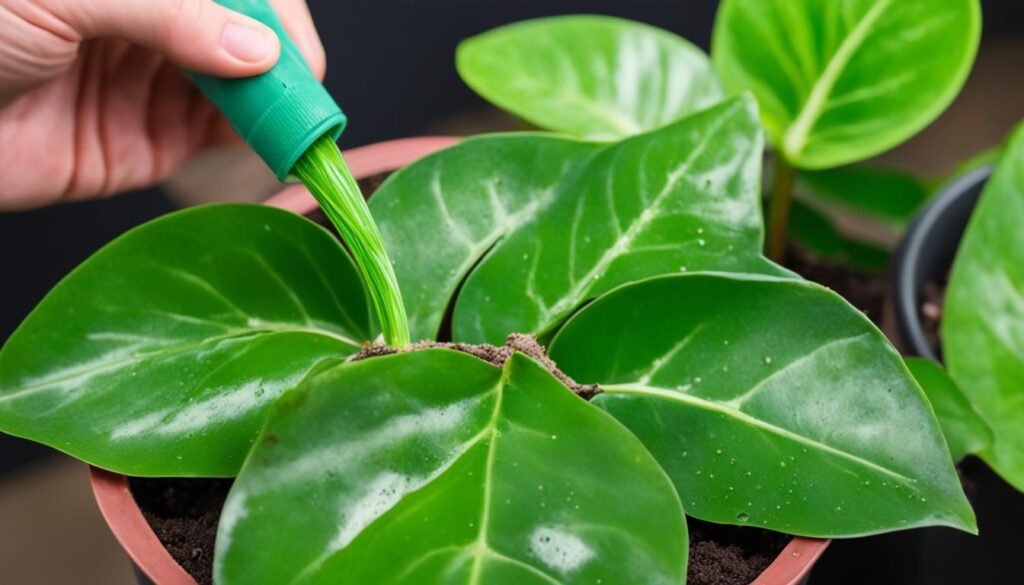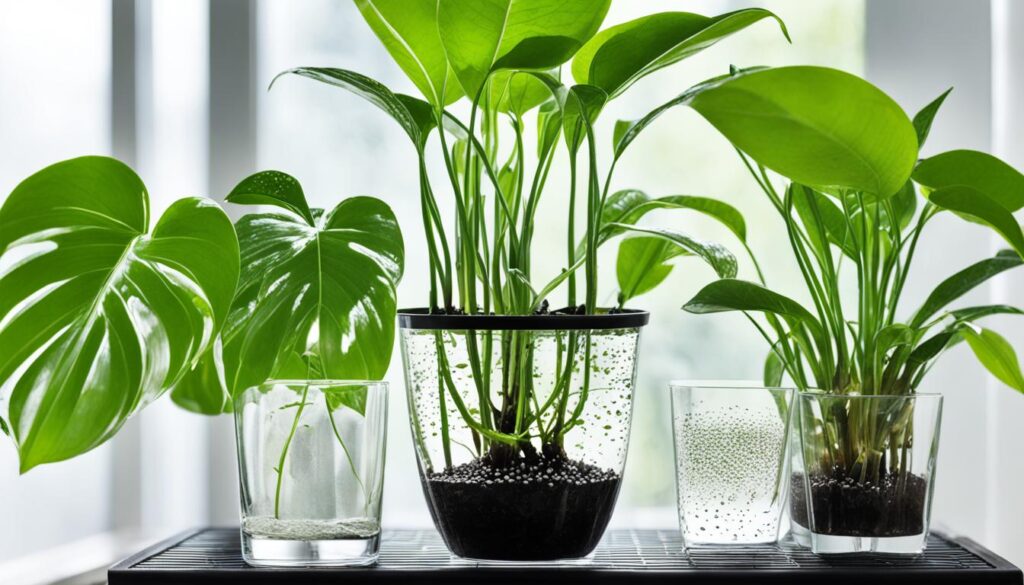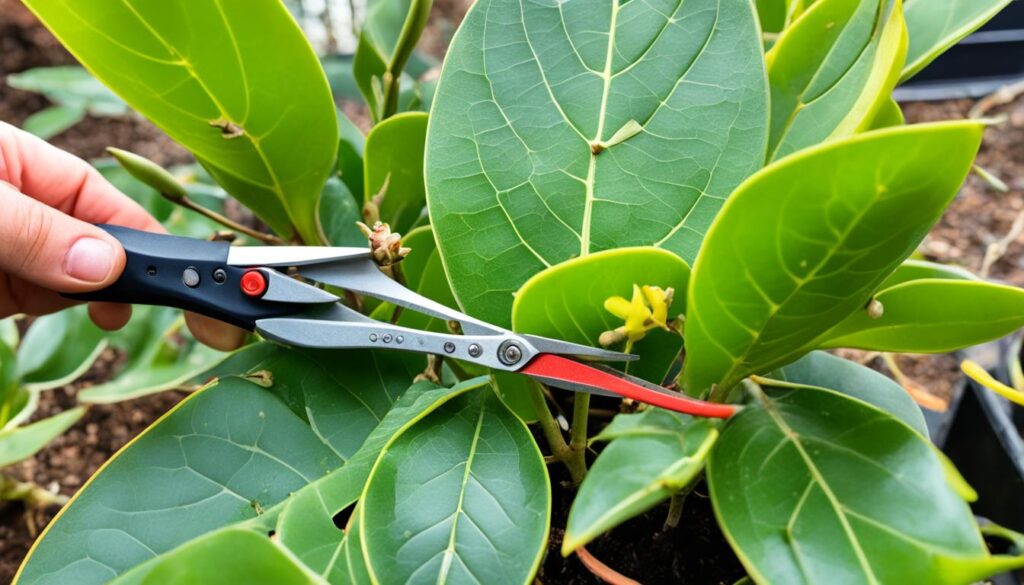Did you know rubber plants, also known as Ficus Elastica, are easy to grow at home? In fact, over 60% of indoor gardeners have successfully grown more of these plants. Whether you’re an expert or just starting, learning to grow your rubber plant is simple and rewarding.
This guide will show you seven easy steps to grow your rubber plant. You’ll learn how to pick the right cuttings and keep the right environment. With patience and the right methods, you’ll see your new rubber plant flourish indoors.
Key Takeaways
- Rubber plants can be easily propagated at home, with over 60% of indoor gardeners succeeding in the process.
- The guide covers seven simple steps to successfully propagate a rubber plant, from cutting selection to environment maintenance.
- Rubber plant propagation can be a rewarding and straightforward process for both seasoned plant enthusiasts and beginners.
- Proper techniques and patience are key to ensuring the successful growth of a new rubber plant.
- Propagating rubber plants can help expand your indoor garden with ease.
Introduction to Rubber Plant Propagation
Propagation means making new plants from old ones. For rubber plants (Ficus elastica), you can use stem cuttings or air layering. Stem cuttings are faster and simpler for beginners.
Understanding the Benefits of Plant Propagation
Propagating rubber plants has many perks. You can grow more of your favorite plants, share them with loved ones, or sell them. It also keeps your plant collection diverse and ensures you always have plants.
Rubber Plants: A Beginner-Friendly Species
Rubber plants, or Ficus elastica, are perfect for starting out. They’re tough and can do well indoors. With constant new growth, they’re great for beginners looking to grow rubber plants.
“Propagation is the key to expanding your rubber plant collection and sharing the joy of these resilient, low-maintenance plants with others.”
Choosing the Right Time to Propagate
Timing is crucial when propagating your rubber plant. The best time to propagate rubber plants is during the active growing season, from late spring to early summer. This is when the plant is ready for growth, and new cuttings have the best chance to root well.
Don’t try to propagate during the plant’s dormant winter months. The cooler temperatures and less sunlight make it hard for cuttings to grow. Propagating in spring or early summer gives your new plants a strong start. This ensures they grow into healthy, vibrant additions to your collection.
“Patience is required for the growth of propagated plants into mature mother plants.”
The timing of rubber plant propagation is important. New plants may take several months to be ready for soil. But with the right care, you can successfully propagate your rubber plant and watch it flourish.

Propagating your rubber plant in the growing season is a cost-effective way to grow your collection. It’s great for gifting too. By following the right timing and techniques, you’ll be on your way to successfully propagating your rubber plant. Enjoy its benefits for years to come.
Selecting the Perfect Rubber Plant Cutting
Choosing the right stem for your rubber plant is key to growing new plants. Look for healthy rubber plant cuttings that will do well.
Identifying Healthy Stem Cuttings
Find a mature, healthy stem that’s 4-6 inches long with two to three leaves. Don’t use stems that are too young or too old. They might not root well. The stem should be strong and without damage or color issues.
To get your rubber plant cuttings ready, cut a clean piece just below a node with a sharp knife or shears. Then, take off the lower leaves, leaving a few at the top. This helps the cutting use its energy for roots.
Preparing Cuttings for Successful Rooting
- Pick a healthy, mature stem that’s 4-6 inches long with at least 2-3 leaves.
- Use a clean, sharp knife or pruning shears to make a clean cut just below a node.
- Remove the lower leaves, leaving 1-2 leaves at the top to reduce moisture loss.
- Avoid using stems that are too young or too old, as they may not root well.
- Handle the rubber plant cuttings carefully to prevent damage or irritation from the sap.
By picking and preparing the right rubber plant cuttings, you’re on your way to growing new, healthy plants.
“The secret to successful rubber plant propagation lies in choosing the right stem cuttings. With a little care and attention, you can create multiple thriving plants from a single parent.”
Using Rooting Hormones for Enhanced Success
Using a rooting hormone can greatly improve your rubber plant propagation. It’s not always needed but can help with root growth and speed up the process.
To use a rooting hormone, dip the cut stem end into the hormone powder and gently tap off any extra. This encourages healthy, strong roots. These roots are key for the cutting to grow into a strong plant.
Rooting hormones are easy to find at garden centers and online. They are a great tool for anyone who loves rubber plants. With a rooting hormone, you boost your chances of successful propagation and see your new rubber plant grow well.
“Using a rooting hormone is like giving your rubber plant cutting a head start on its journey to becoming a healthy, independent plant.”
The benefits of rooting hormone for rubber plants include faster root growth and higher success rates. This means more of your cuttings will root and flourish.
- Stimulates rapid root growth for quicker establishment
- Increases the chances of successful propagation
- Readily available and easy to use
- Can be a valuable tool for both novice and experienced gardeners

If you want to propagate your rubber plant successfully, think about using a rooting hormone. It’s a simple, effective way to help your cuttings grow into healthy, beautiful plants.
Planting the Rubber Plant Cutting
Propagating a rubber plant from cuttings is a great way to grow more plants or share them with others. After picking a healthy stem cutting, it’s time to plant it. The right potting mix and conditions are key for success.
Choosing the Right Potting Mix
For planting your rubber plant cutting, use a potting mix made for succulents or cacti. These mixes are light and airy, helping the cutting grow strong roots. Heavy mixes can cause waterlogging and harm the cutting.
Creating the Ideal Planting Environment
Next, prepare the soil for planting. Fill a small pot with the chosen soil. Make a hole and put the cutting in, making sure the node is covered. Press the soil around the cutting to keep it stable.
Good lighting is important for your rubber plant cutting. Put the pot in a spot with bright, indirect sunlight. Keep it away from direct sunlight to prevent damage. The ideal temperature is 65-85°F (18-29°C) for root growth.
Water the cutting just enough to settle the soil. Don’t overwater, as it can cause rot. Check the soil often and water only when the top inch or two feels dry.
With the right mix and environment, your rubber plant cutting will thrive. Follow these steps to grow your own rubber plant successfully.
Maintaining the Ideal Propagation Environment
Creating a favorable environment is key for your rubber plant cuttings to thrive. You need to focus on humidity and temperature for the best results.
Humidity and Temperature Requirements
Rubber plant cuttings do well in a humid setting, similar to their natural home. To get the right humidity for rubber plant cuttings, cover the pot with a plastic bag or a clear dome. This creates a mini-greenhouse effect, keeping moisture in and helping roots grow. Just remember to let the air in every day to prevent mold.
Keeping the right temperature for rubber plant cuttings is also crucial. They like warm temperatures, between 65°F and 85°F (18°C and 29°C). Don’t let the temperature change too much, as this can harm the plant.
To make sure your rubber plant cuttings grow well, check the soil often. It should be damp but not too wet. Too much water can cause root rot, so be careful.
“Proper environmental conditions are the key to successful rubber plant propagation. Maintaining the right humidity and temperature levels will give your cuttings the best chance of thriving.”
By setting up and keeping the right environment for your rubber plant cuttings, you’re on your way to success. Enjoy your propagation journey!

Monitoring Progress and Identifying Root Growth
Propagating a rubber plant through cuttings needs patience and attention. As you start, it’s key to monitor the progress of your rubber plant cutting and look for new growth signs. This careful watching will help make sure your efforts pay off and your new plant grows well.
Seeing new leaves on your cutting is a big deal. It means the roots have grown well. This change shows your cutting is now a strong, independent plant.
To identify root growth in your rubber plant cuttings, gently pull on the cutting after a few weeks. If it doesn’t move easily, it means roots have formed and are holding the plant in place. You might also see the cutting stay still more easily as the roots get stronger.
“Patience and diligence are key when propagating rubber plants. Trust the process, and you’ll be rewarded with a thriving new addition to your plant collection.”
Root growth can take time, so don’t worry if you don’t see roots right away. Make sure your cutting has the best conditions to grow. With patience and care, you’ll soon have a healthy rubber plant.
- Regularly check for signs of new growth, such as emerging leaves.
- Gently tug on the cutting to assess root development.
- Be patient and maintain the optimal propagation conditions.
By monitoring the progress of your rubber plant cutting and spotting root growth, you’re on your way to growing a new, healthy rubber plant.
Transplanting the New Rubber Plant
When your rubber plant grows strong roots, it’s ready for a bigger pot. It’s important to transplant it right for its growth and health.
Preparing the New Potting Mix
Choose a pot that’s one size bigger than the current one. Fill it with a potting mix made for rubber plants. This mix gives your plant the nutrients and drainage it needs.
Proper Transplanting Techniques
- Gently remove the rubber plant from its pot without harming the roots.
- Put the plant in the new pot’s center and fill the sides with potting mix.
- Water the soil lightly to settle it and ensure no air pockets around the roots.
- Place the plant where it gets bright, indirect sunlight. Rubber plants love lots of light.
Putting the rubber plant in a bigger pot helps it keep growing. Make sure to water it often, as it likes moist but well-draining soil. With the right care, your rubber plant will keep thriving and make your space look beautiful.

“Proper transplanting is crucial for the continued growth and health of your new rubber plant.”
Ongoing Care for Propagated Rubber Plants
Congratulations on successfully propagating your new rubber plant! Now, it’s time to focus on the right care to help your plant thrive. Caring for propagated rubber plants and maintaining healthy propagated rubber plants means paying attention to their needs.
Rubber plants love bright, indirect light. Stay away from direct sunlight, as it can burn the leaves. Try to put your plant in a spot that gets a few hours of morning or evening sun. Make sure the soil dries out a bit between waterings.
- Water your rubber plant when the top inch of soil feels dry.
- Don’t overwater, as this can cause root rot and other problems.
- Regularly wipe the leaves with a damp cloth to remove dust and keep them clean.
As your rubber plant grows, you might need to prune it. This keeps its shape and encourages bushier growth. Use clean, sharp pruners to cut off any dead or damaged leaves or stems. This keeps your plant healthy and looking good.
“Consistent care ensures your plant remains healthy and attractive.”
Fertilizing your rubber plant helps it thrive. In the growing season (spring and summer), use a balanced, water-soluble fertilizer every two to four weeks. Cut back on fertilizing in the winter when the plant is dormant.
Remember, patience and watchfulness are crucial when caring for propagated rubber plants and maintaining healthy propagated rubber plants. With the right conditions and care, your new rubber plant will become a beautiful, lasting part of your indoor garden.
how to propagate rubber plant
Propagating your rubber plant is a great way to grow your indoor garden and share its beauty. By following simple steps, you can grow more plants. Let’s explore how to propagate a rubber plant.
Selecting the Right Stem Cuttings
Start by picking healthy, mature stems for cuttings. Choose stems that are pest or disease-free. Pick stems that are 4-6 inches long with a few leaves. Don’t use stems from the top or bottom as they might not root well.
Preparing the Cuttings
After picking your stems, prepare them for planting. Cut the stems just below a leaf node with clean scissors or pruners. Remove the lower leaves, leaving 2-3 leaves at the top. This helps the cutting focus on roots, not leaves.
Rooting the Cuttings
Encourage root growth by dipping the cut end in rooting hormone. This hormone helps new roots develop, giving your cuttings a boost.
Planting the Cuttings
Now, plant your cuttings in a potting mix that drains well. Put the cuttings 2-3 inches deep. Water gently and keep the soil moist but not too wet to prevent rot.
With patience and care, your cuttings will start to grow roots and new leaves. Watch for progress and move the rooted cuttings to their own pots when they’re ready.

By following these steps, you’ll grow more rubber plants and enjoy your indoor garden. Happy gardening!
Troubleshooting Common Propagation Issues
Propagating a rubber plant can be rewarding but has its challenges. If your rubber plant cutting isn’t rooting, tackle common issues to help it succeed.
Addressing Light, Humidity, and Temperature Problems
Ensuring the right light, humidity, and temperature is crucial for rubber plant propagation. Troubleshooting rubber plant propagation issues often means adjusting these factors.
- Light: Rubber plant cuttings need bright, indirect light. Direct sunlight can harm the leaves, while too little light stops rooting. Look for a spot with 6-8 hours of filtered sunlight daily.
- Humidity: High humidity is vital for rubber plant cuttings. Use a plastic dome or bag to keep it humid, and mist the leaves often.
- Temperature: Rubber plants do well in warm places, between 70-75°F (21-24°C). Keep cuttings above 65°F (18°C) to help roots grow.
By watching and adjusting the light, humidity, and temperature, you can fix common propagation problems. This will help your cutting root successfully.
“Proper environmental conditions are crucial for the success of rubber plant propagation. Get the light, humidity, and temperature right, and you’re well on your way to growing a thriving new plant.”
Patience and detail are important when propagating rubber plants. With the right changes, you can beat common challenges and see a new rubber plant grow and flourish.
Propagation Methods: Stem Cuttings vs. Air Layering
There are two main ways to grow rubber plants: stem cuttings and air layering. Each method has its own benefits. It’s key to know the differences to pick the best one for you.
Stem cuttings are great for beginners because they’re easy to do. They have an 80% success rate in growing rubber plants. You take a cutting from a healthy stem and put it in soil. This method is quick and doesn’t cost much.
For those looking for a bit more challenge, air layering is a top choice. It has a 95% success rate. This method helps the plant grow roots while it’s still attached to the parent plant. It takes more work but can lead to faster-growing plants.
Rubber plants grown through air layering grow faster than those from stem cuttings. This is great for gardeners who want quick results. But, air layering can be more expensive.
Choosing between stem cuttings and air layering depends on what you prefer and your experience. Both methods can help you grow healthy rubber plants. It’s about what works best for you.
rubber plant propagation methodsandstem cuttings vs air layeringare key when growing these popular houseplants.

“Propagating rubber plants through air layering may require more time and effort, but the significantly higher success rate makes it a worthwhile investment for many gardeners.”
Conclusion
Propagating your rubber plant is a great way to grow your indoor garden. This guide shows you how to make new plants from stem cuttings. Choose the right time, pick healthy cuttings, and keep the right environment for rooting.
It takes some work to propagate rubber plants, but it’s worth it. Watching a cutting grow into a new plant is very rewarding. With the right methods and care, you can have many rubber plants at home.
Starting your rubber plant propagation journey means being patient and careful. With the right advice and attention, you’ll soon be growing your rubber plants. Enjoy the beauty and clean air they bring to your home. Happy propagating!


